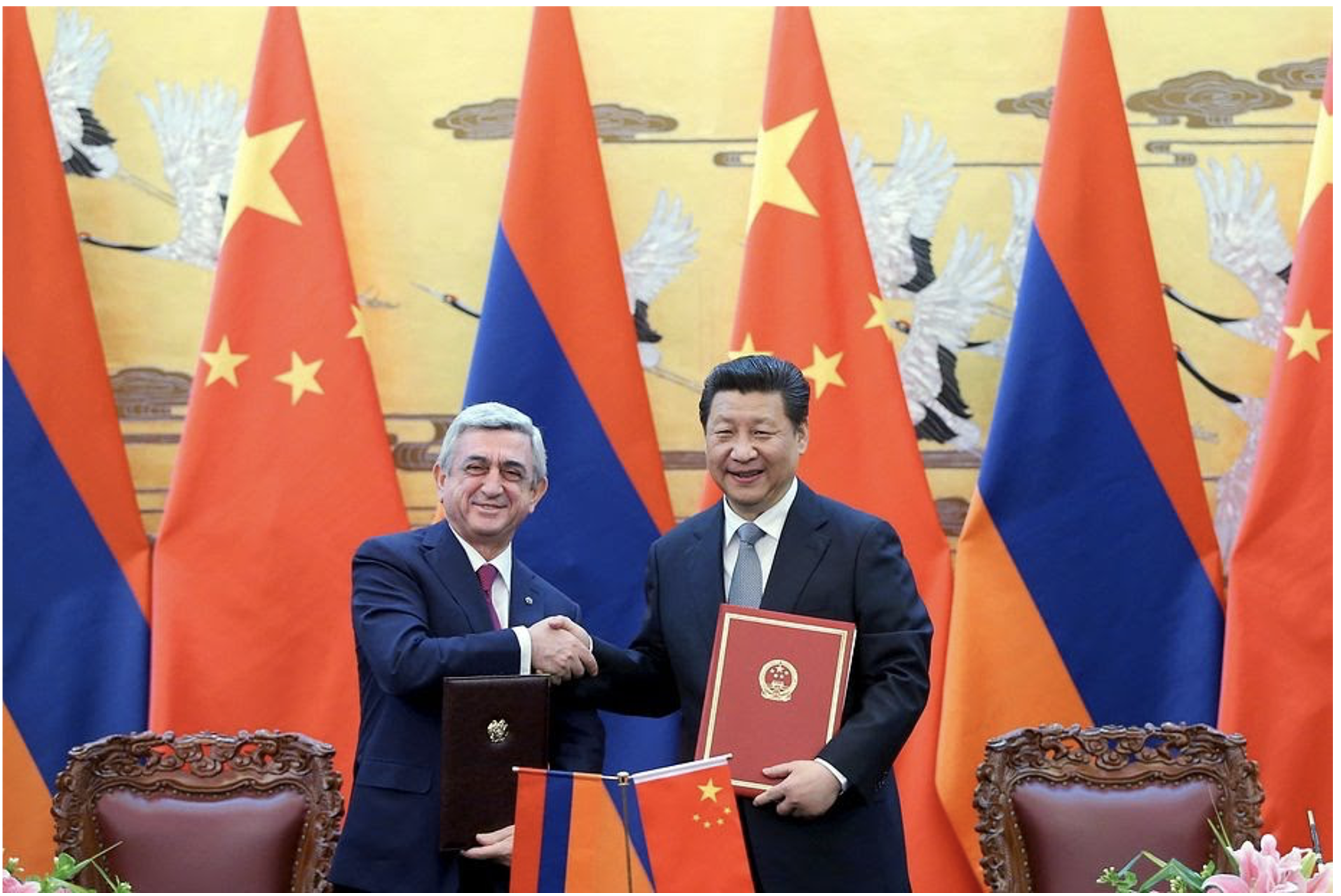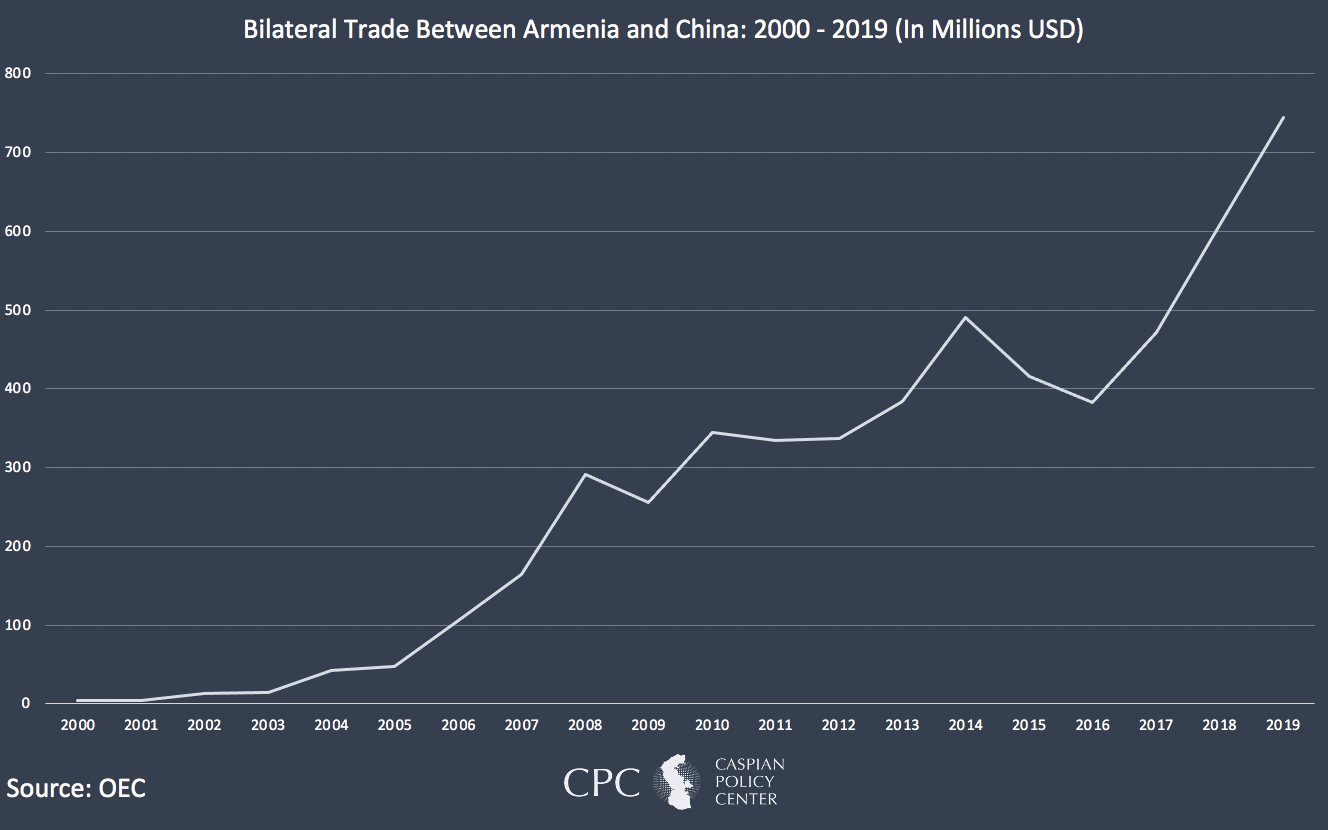China-Armenia Bilateral Relations
Recent Articles
Author: Dante Schulz
01/26/2022
This piece is part of a series by Dante Schulz and CPC’s Senior Fellows that researches the bilateral relationship between China and the 8 Caspian countries. CPC will release one article on each of the countries and publish a volume encompassing all the research after the last article is released."
Beijing established relations with Yerevan soon after Armenia’s independence from the Soviet Union in December 1991. Ever since, Armenia has been an important node for China’s foreign policy agenda in the South Caucasus. Both former Prime Minister Serzh Sargsyan and current Prime Minister Nikol Pashinyan received warm receptions when they visited China.i In 2020, China opened its second-largest embassy complex in the former Soviet Union in Yerevan, an action seen as underscoring Armenia’s role in China’s foreign policy agenda.ii
Soft power initiatives are important in China’s engagement with Armenia. Beijing established the first Confucius Institute in the South Caucasus at Yerevan State University to promote Chinese culture throughout the country and the region.iii Yerevan and Beijing also jointly constructed a Chinese language-studies school in 2014. The school has a capacity of 650 Armenian students and is the largest Chinese language center in the former Soviet Union.iv With an increase in the number of Chinese language speakers in Armenia and with the rise in the number of Armenians who have received education to understand the complexities of China’s foreign policy, healthier, fuller bilateral relations between Armenia and China will likely follow. Armenians educated in Confucius Institutes and Chinese language centers will be able to more appropriately advise Yerevan on forging deeper connections with Beijing.
 Former Armenian Prime Minister Serzh Sargsyan and Chinese President Xi Jinping shake hands in Beijing after signing a Belt and Road Initiative memorandum in Beijing in 2015. (Reuters | Feng Li)
Former Armenian Prime Minister Serzh Sargsyan and Chinese President Xi Jinping shake hands in Beijing after signing a Belt and Road Initiative memorandum in Beijing in 2015. (Reuters | Feng Li)
Economic Relations
In 2019, the Armenian government declared the start of what Prime Minister Pashinyan called an “economic revolution” to spur business growth and expand global investment partnerships.v Prime Minister Pashinyan declared that this domestic economic revolution would address the economic problems that occurred and were inherited from Sargsyan’s administration by expanding employment opportunities for all Armenians and decreasing poverty.vi Progress on this front, however, seems limited – including because of the COVID 19 pandemic – and economic well-being remains an important domestic concern.
Bilateral trade between Armenia and China has grown substantially over the past two decades. In 2019, Armenian exports to China totaled $220 million while Chinese exports to Armenia amounted to $525 million, resulting in a $305 million trade deficit with China. An increase in bilateral trade with China during the COVID-19 pandemic allowed China to cement itself as Armenia’s second-largest trading partner, following Russia.vii While Armenia relies on China for essential goods, e.g., machinery, including telephones, refrigerators, and lifting machines, as well as pesticides, and various metals, the overall volume of trade remains relatively small with Armenia ranking as China’s 137th largest trading partner.viii
Armenia is a member of the Russian-led Eurasian Economic Union (EAEU) and has signed a Comprehensive and Enhanced Partnership Agreement with the European Union.ix However, to link itself better with partners to the east, Armenia is prioritizing developing its transportation infrastructure. Armenia has developed the North-South Road Corridor project to reconstruct 345-miles worth of road to slash transport times from the Armenia-Iran border to the Armenia-Georgia border, with support from the Asian Development Bank.x In 2018, the China-based Asian International Investment Bank (AIIB) published “Transport Sector Strategy: Sustainable and Integrated Transport for Trade and Economic Growth in Asia” flagging Beijing’s hopes to improve infrastructure across the Asian continent. The report’s contents track with Armenia’s thinking and plans for its North-South Road Corridor. Success with the North-South Corridor is seen as something that could prompt China to consider Armenia as a partner in achieving its infrastructure and connectivity goals.xi
Armenia signed the Memorandum on Promotion of Cooperation in Building the Silk Road Economic Belt in 2015, making the country an official participatory partner to China’s Belt and Road Initiative (BRI).xii Since the signing, China has initiated two BRI projects with Armenia totaling $10 million. While those figures suggest Chinese BRI activity is lower in Armenia than elsewhere, there was still a 209 percent increase in average Chinese official financial commitments between the year before Armenia joined the BRI and the year after. It is likely that if Armenia ended its self-isolation and established robust links with neighbors other than Georgia and Iran, more BRI-related funding might be forthcoming.
Armenia’s isolation from Turkey and Azerbaijan for foreign policy reasons inhibits its participation in BRI corridors and projects. Only its northern border with Georgia and its southern border with Iran are open, and goods could just as easily be transported between these two countries via Azerbaijan. Furthermore, Armenia’s dilapidated infrastructure network and weak road access, especially in rural regions,xiii are limiting factors.xiv Delivery of Chinese goods and services to support Chinese-financed infrastructure projects in Armenia confront significant delays due to infrastructure problems. Meanwhile, Georgia and Iran are full-fledged participants of both the BRI and AIIB, while Armenia is not involved in the AIIB.

Security Relations
China has maintained a neutral stance in the protracted conflict between Armenia and Azerbaijan and towards the South Caucasus in general. China, however, sold Armenia NORINCO WM-80 multiple-launch rocket systems in 1999. This was the first Chinese military sale in the South Caucasus and the first Armenian acquisition of major defense weapons from outside the former Soviet Union.xv Armenia obtained additional Chinese rockets in 2013 after Beijing and Yerevan inked an “agreement on military and military-technical cooperation,” according to the Armenian Defense Ministry in 2012.xvi At the same time, China abstained from voting at the UN General Assembly in 2008 over the Karabakh conflict.xvii Moreover, China supported neither side in the 2020 Karabakh War.
 Armenian-Chinese relations can be dated back to the Middle Ages. Chinese porcelain and celadonite have been found in Armenian archaeological sites, most probably brought by Silk Road travel. (Art-A-Tsolum)
Armenian-Chinese relations can be dated back to the Middle Ages. Chinese porcelain and celadonite have been found in Armenian archaeological sites, most probably brought by Silk Road travel. (Art-A-Tsolum)
Conclusion
Armenia has made itself a reliable strategic partner for China despite its geographical distance from the country. Nevertheless, infrastructure inefficiencies and isolation from its neighbors have constrained China’s ability to expand in the South Caucasus country. Therefore, high-ranking officials in Armenia are not sounding the alarm about the same predatory lending practices employed by China that many around the world have been concerned about.xviii While there are not as many investment projects underway in Armenia, Yerevan should seek to expand its outreach with China and focus on improving its relations with its immediate neighbors to sell itself as a more lucrative investment destination for Chinese infrastructure financing.
I (2019, May 1). Interview: BRI creates increasing cooperation opportunities for Armenia, China: expert. Xinhuanet. http://www.xinhuanet.com/english/2019-05/01/c_138027336.htm.
II Abrahamyan, P. (2019, March 5). Economic Revolution or Hopes for a Miracle. Evn Report. https://www.evnreport.com/economy/economic-revolution-or-hopes-for-a-miracle.
III (2021, September 15). Chinese-Armenian Trade Grows Despite Global Recession. Azatutyun. https://www.azatutyun.am/a/31104032.html.
IV OEC. China / Armenia. https://oec.world/en/profile/bilateral-country/chn/partner/arm
V Poghosyan, B. (2021, September 2). To Boost Armenian Economy, Economic Cooperation with China is a Must. IndraStra Global. https://www.indrastra.com/2021/09/China-Armenia-Eoc.html.
VI (2021, July 21). IRD Engineering to supervise another section of the North-South Road Corridor Investment Program in Armenia. IRD Engineering. https://irdeng.com/2021/07/21/ird-engineering-to-supervise-another-section-of-the-north-south-road-corridor-investment-program-in-armenia/.
VII Sahakyan, M. (2019, November 29). Belt and Road: Prospects for Sino-Armenian cooperation in the financial-banking sphere. Modern Diplomacy. https://moderndiplomacy.eu/2019/11/29/belt-and-road-prospects-for-sino-armenian-cooperation-in-the-financial-banking-sphere/.
VIII Bergmann, S. (2019, December 16). Armenia in the Belt and Road Initiative. Evn Report. https://www.evnreport.com/economy/armenia-in-the-belt-and-road-initiative.
IX (2016, November 3). Better, Safer Roads Lead to Improving Lives in Rural Armenia. World Bank. https://www.worldbank.org/en/news/feature/2016/10/31/better-safer-roads-lead-to-improving-lives-in-rural-armenia
X The World Bank. (June 2020). South Caucasus and Central Asia: The Belt and Road Initiative Armenia Country Case Study. The World Bank. Retrieved October 27, 2020, from https://openknowledge.worldbank.org/bitstream/handle/10986/34120/South-Caucasus-and-Central-Asia-The-Belt-and-Road-Initiative-Armenia-Country-Case-Study.pdf?sequence=4&isAllowed=y.
XI Sanamyan, E. (2016, February 6). China in the Caucasus. The Diplomat. https://thediplomat.com/2016/02/china-in-the-caucasus/.
XII Harutyunyan, S. (2013, October 19). New Chinese Rockets ‘Acquired by Armenia’. Azatutyun. https://www.azatutyun.am/a/25080110.html.
XIII Sanamyan, E. (2016, February 6). China in the Caucasus. The Diplomat. https://thediplomat.com/2016/02/china-in-the-caucasus/.
XIV Elliott, R. (2019, January 3). Is Armenia Playing a Dangerous Game With China? The Armenian Weekly. https://armenianweekly.com/2019/01/03/is-armenia-playing-a-dangerous-game-with-china/.
XV Azadian, E. Y. (2020, September 17). The Confluence of Armenian-Chinese Interests. Mirror-Spectator. https://mirrorspectator.com/2020/09/17/the-confluence-of-armenian-chinese-interests/.
XVI (2020, September 23). China Opens New Embassy Complex in Armenia. Azatutyun. https://www.azatutyun.am/a/30854041.html.
XVII Bergmann, S. (2019, December 16). Armenia in the Belt and Road Initiative. Evn Report. https://www.evnreport.com/economy/armenia-in-the-belt-and-road-initiative?__cf_chl_jschl_tk__=pmd_kDZBn9uwkEPGuZrjd35kka3eaOfiKPi2J4DdPAlgnM8-1634657783-0-gqNtZGzNAnujcnBszQbR.
XVII Musaelyan, O. (2017, August 23). Armenia: New Embassy is Sign of Strengthening Chinese-Armenian Ties. Eurasianet. https://eurasianet.org/armenia-new-embassy-is-sign-of-strengthening-chinese-armenian-ties.